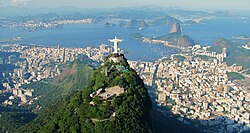Anáheiro: Difference between revisions
(Created page with "{{Infobox settlement | name = Anaheiro | official_name = Anáheiro | native_name = Cidade de Anáheiro | image_skyline = Cidade Maravilhosa.jpg | image_caption = View of Anáheiro | image_flag = Bandeira da cidade do Rio de Janeiro.svg | image_seal = Brasão da cidade do Rio de Janeiro.svg | population_total = 25,369,018 | population_demonym = narano | founder = Camillus Petellius Donicus | named_for...") |
No edit summary |
||
| Line 27: | Line 27: | ||
The city of Anáheiro is the second-largest in [[Carinansia]], third-largest in Oikoia, sixth-largest in the Eastern Hemisphere, and the fifteenth-largest in the world. As a prominent financial, shipping, and tourist hub, the city facilitates over a trillion pesos of trade annually. Originally founded as a slave-trading settlement in 1572, it was formally incorporated as a city in 1699. From 1830 to 1965, it was the fifth-largest city, and quickly grew as it received internal migrants from San Luis and Mangulak, as well as international migrants fleeing external conflicts and seeking economic opportunity. Since 1974, it has been the second-largest city in [[Carinansia]], and is home to the Anáheiro Stock Exchange, the state's premier stock exchange worth approximately $1.3T in 2100. | The city of Anáheiro is the second-largest in [[Carinansia]], third-largest in Oikoia, sixth-largest in the Eastern Hemisphere, and the fifteenth-largest in the world. As a prominent financial, shipping, and tourist hub, the city facilitates over a trillion pesos of trade annually. Originally founded as a slave-trading settlement in 1572, it was formally incorporated as a city in 1699. From 1830 to 1965, it was the fifth-largest city, and quickly grew as it received internal migrants from San Luis and Mangulak, as well as international migrants fleeing external conflicts and seeking economic opportunity. Since 1974, it has been the second-largest city in [[Carinansia]], and is home to the Anáheiro Stock Exchange, the state's premier stock exchange worth approximately $1.3T in 2100. | ||
== History == | |||
== Economy == | |||
Anáheiro is considered the tourist and entertainment capital of Oikoia, as it is the one of the largest recipients of international and domestic tourists in the world. One of the wealthiest cities in the country, tax incentives have facilitated the establishment of the local film production industry in the 2030s. According to data from the ICGE, its gross metropolitan product (GMP) in 2096 was CAR$1.5T, 8.1% of Carinansia’s GDP, and 81.2% of the state's GRP. According to Gennegneux Co. average annual economic growth of the city is 2.3%. Anáheiro also has a large "informal" economy, primarily consisting of legal goods sold untaxed, as well as decriminalised narcotics. In 2096, the city of Anáheiro collected CAR$110 billion in taxes and the city budget was CAR$90 billion. The city has 3,875 bank branches and 100 shopping malls. | |||
As of 2095, Anáheiro’s economy is dominated by tourism, and tertiary services, although the quaternary sector has seen recent growth, due to extensive state investments into the State University of Anáheiro. Since the Santana recession of the 2070s, the city has been largely deindustrialised, with most manufacturing corporations moving to San Luis, and São Lenoas, preferring the local ordinances and more educated populations. | |||
Latest revision as of 08:49, 17 April 2024
Anaheiro
Cidade de Anáheiro | |
|---|---|
| Anáheiro | |
 View of Anáheiro | |
| First settled | c. 3000 BCE |
| Incorporated as a town | March 9, 1572 |
| Incorporated as a city | October 8, 1699 |
| Founded by | Camillus Petellius Donicus |
| Named for | January in Classical Spanic |
| Seat | San Roberto Administrative Zone |
| Boroughs | List of Boroughs |
| Government | |
| • Type | Mayor–council government |
| • Body | Metropolitan Council of Anáheiro |
| • Mayor | Javier Serrano Lugo (Union Socialist Party) |
| Population | |
| • Total | 25,369,018 |
| Demonym | narano |
The city of Anáheiro is the second-largest in Carinansia, third-largest in Oikoia, sixth-largest in the Eastern Hemisphere, and the fifteenth-largest in the world. As a prominent financial, shipping, and tourist hub, the city facilitates over a trillion pesos of trade annually. Originally founded as a slave-trading settlement in 1572, it was formally incorporated as a city in 1699. From 1830 to 1965, it was the fifth-largest city, and quickly grew as it received internal migrants from San Luis and Mangulak, as well as international migrants fleeing external conflicts and seeking economic opportunity. Since 1974, it has been the second-largest city in Carinansia, and is home to the Anáheiro Stock Exchange, the state's premier stock exchange worth approximately $1.3T in 2100.
History
Economy
Anáheiro is considered the tourist and entertainment capital of Oikoia, as it is the one of the largest recipients of international and domestic tourists in the world. One of the wealthiest cities in the country, tax incentives have facilitated the establishment of the local film production industry in the 2030s. According to data from the ICGE, its gross metropolitan product (GMP) in 2096 was CAR$1.5T, 8.1% of Carinansia’s GDP, and 81.2% of the state's GRP. According to Gennegneux Co. average annual economic growth of the city is 2.3%. Anáheiro also has a large "informal" economy, primarily consisting of legal goods sold untaxed, as well as decriminalised narcotics. In 2096, the city of Anáheiro collected CAR$110 billion in taxes and the city budget was CAR$90 billion. The city has 3,875 bank branches and 100 shopping malls.
As of 2095, Anáheiro’s economy is dominated by tourism, and tertiary services, although the quaternary sector has seen recent growth, due to extensive state investments into the State University of Anáheiro. Since the Santana recession of the 2070s, the city has been largely deindustrialised, with most manufacturing corporations moving to San Luis, and São Lenoas, preferring the local ordinances and more educated populations.